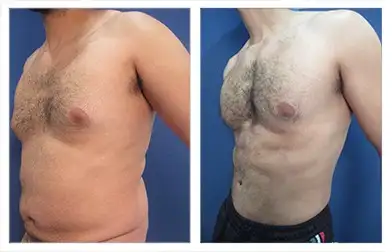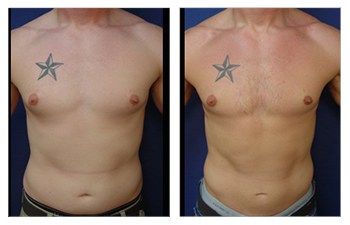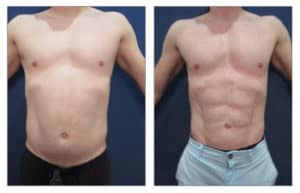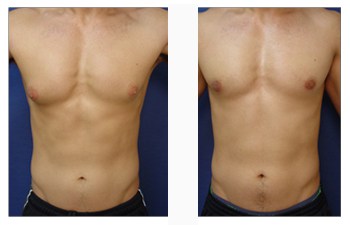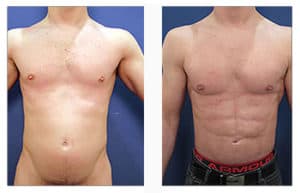WANT THE CONFIDENCE THAT COMES WITH
KNOWING YOU LOOK YOUR BEST?
Male breast surgery CASE STUDIES
Male breast surgery is evolving. This page begins with Dr. Paris's surgical results and goes into detail about expectations, risks and frequently asked questions. Please read on.
male breast surgery CASE STUDIES
Male breast surgery is evolving. This page begins with Dr. Paris's surgical results and goes into detail about expectations, risks, and frequently asked questions. Please read on.
Male Breast Surgery
Male breast surgery has recently developed following the advent of high definition male abdominal etching. Previously, men were observed desiring a defeminization surgery that would essentially flatten their chest, called gynecomastia surgery. Traditional gynecomastia surgery involved the complete removal of the mammary glandular tissue as well as conservative removal of the fatty breast tissue in the peripheral chest region. Removal of the glandular tissues could be accomplished with liposuction and/or direct excision of the glandular tissues. The area of removal would then be smoothened with the breast periphery with conservative liposuction. Instead, today men are desiring masculinization surgery that demands a strong and bold chest contour. A masculine chest contour requires the creation of an armor plate appearance that has a flat central region but a prominent perimeter much like the appearance of a plateau.
The nuances regarding male breast plastic surgery are several. The first requires a reduction of the glandular tissues located typically under the nipple and areola. Since the entire chest is not being flattened, some retention of glandular tissue is acceptable in order to ensure a smooth contour line. As such, patients may undergo liposuction of the glandular tissue rather than direct excision. This technique of glandular reduction rather than excision avoids a potential surgical scar. It is important to note that VASER liposuction utilizing ultrasound energy is the preferred liposuction technique as it assists with the removal of firmer glandular tissues. The second component is the creation of bold and linear borders that are best characterized by a pentagonal shape. The pentagon includes a horizontal lower border, a small oblique, and longer vertical medial border, and a vertical oblique, lateral border. The upper border is defined by the horizontal collar bone. Just under the clavicle, there is an infraclavicular triangular concavity that is aesthetically unique to the chest which should not be altered.
The goals of male breast and chest surgery include not only reduction of the central glandular tissues but also fat transfer to the above inferior, the lateral oblique and medial oblique and vertical borders. To create these strong borders two maneuvers are required. The first requires intramuscular fat grafting of the chest border to not only strengthen the perimeter but also transform curved lines into straight lines. In addition, the chest borders, i.e. adjacent areas, must be debulked. These debulked areas include the removal of fat from the upper abdominal inscription line, the axillary region, and the sternal line using liposuction techniques.
In summary creation of the armor plate, chest appearance is critical to creating a masculinized chest that is harmonious when interposed on a high definition etched abdomen. Male breast and chest surgery has undergone an evolution in aesthetics that is inherent in the male body contouring transformations available today.
We built Just4Males.com for you - check it out!
Procedure
Male breast and chest surgery requires the creation of a masculinized male breast contour that is depicted by an armor plate appearance.
Length
Surgery can be performed in 20 minutes.
Anesthesia
Male breast surgery can be performed under local or general anesthesia.
Place of Treatment
Surgical suite
Side Effects
Contour irregularities
Recovery
Male breast surgery patients routinely return to working out within 10 days following surgery.
Duration of Outcomes
Male chest and breast surgery will traditionally provide permanent results as long as patients do not undergo major weight gain.
MALE BREAST SURGERY FREQUENTLY ASKED QUESTIONS
What is male breast surgery?
It refers to advancement in surgical algorithms wherein the male chest is made to look more prominent in the shape of an armor plate rather than flat as performed during traditional gynecomastia surgery.
Am I a good candidate for surgery?
You are a good candidate for male chest and breast surgery if you are considering having abdominal etching to achieve a six-pack.
What can I expect at my initial male breast surgery consultation?
First, your chest will be examined to determine the degree of fat excess and skin redundancy that will guide your surgery. Next, your health status will be evaluated and your laboratory values checked. Your nutrition will also be optimized to prepare you for surgery.
What are the risks and complications of male breast surgery procedures?
The most common concern following male breast surgery is to have contour irregularities related to skin redundancy. All efforts are made to ensure that skin redundancy will be accommodated with fat grafting to fill in the chest skin redundancy or to use Renuvion skin tightening. Rarely, patients may have to consider skin excision but this is avoided at all costs to make the surgery inconspicuous.
How is a this surgery procedure performed?
Breast surgery for men is performed using VASER ultrasound-assisted liposuction that allows for not only the removal of fatty tissues but also the reduction of firmer mammary glandular tissue.
What can I expect after surgery?
Breast surgery for males recovery is tolerable with minimal to moderate pain. Patients will find themselves dressed in customized compression garments. Garments should be worn for at least one week. Patients will typically be allowed to return to the gym by 10 days following surgery.
Where are the incisions like following male breast surgery procedure?
Male breast surgery utilizes a single, small porthole measuring 3mm on each breast.
Will I have Scars following my surgery?
There are negligible scars following male breast surgery since a single porthole is used to remove both the glandular tissues and fat as well as to add fat back strategically in order to create the armor plate appearance.
When will I be able to return home after male breast surgery procedure?
You can typically return home following male breast surgery unless more extensive surgeries are being performed synchronously.
PATIENT-SPECIFIC QUESTIONS
Are the mammary glandular tissues removed entirely during surgery?
Typically, the mammary glands are reduced in volume using ultrasound-assisted liposuction since complete flattening of the breast tissues is not indicated. This is in contrast to traditional gynecomastia surgery that includes direct excision of most of the glandular tissues.
Do you need to have an incision around your areola with surgery?
Unlike traditional gynecomastia that requires direct excision of the mammary glandular using an infra-areolar incision, breast surgery for men utilizes liposuction only to reduce the glandular tissue bulk and to remove undesirable fatty tissues. So no lengthy incisions are required.
How long do I need to avoid exercise after male breast surgery?
Since no lengthy incision lines are needed during breast surgery for males and no manipulation of your muscle tissue is required, patients may return to work and physical activity within 10 days following surgery.
When will I notice improvement in my chest appearance after male breast surgery?
You will notice an improvement in her chest appearance right away following your breast surgery. Although you will look much improved right away, you should know that the complete resolution of swelling will not occur for 3 months following surgery. This delay will also allow any skin redundancy to reabsorb itself.



